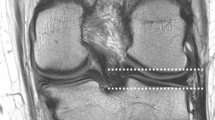Abstract
Anatomical studies show that the native ACL consists of two distinct functional bundles, termed the anteromedial (AM) and posterolateral (PL) bundles. The utility of using routine magnetic resonance imaging (MRI) to distinguish the individual bundles of the ACL has not been evaluated. The purpose of this study was to evaluate the intra- and inter-observer agreement for assessment of the AM and PL bundles using MRI in the axial, coronal, and sagittal viewing planes. We identified a series of patients seen in the senior author’s clinic during a 16-month period. Images were independently evaluated in blinded fashion at two separate time points by a musculoskeletal radiologist and two orthopaedic residents. The AM bundle was detected in most planes of view with high frequency and reliability, while detection of the PL bundle was less frequent and had a lower associated reliability. Our results indicate that it is difficult to reliably detect both the AM and PL bundles using a low-field strength magnet with standard planes of view. It has been demonstrated that the ACL may be imaged effectively in planes that are based on the natural course of the ligament, and it is likely that this will also facilitate visualization of the individual AM and PL bundles. The use of additional oblique planes of view offers a potential approach for improved evaluation of the ACL, even with low field strength magnets. Future work in this area may assist in the pre-operative assessment of isolated AM or PL bundle injuries, facilitating a more anatomic approach to ACL reconstruction.


Similar content being viewed by others
References
Amis AA, Dawkins GPC (1991) Functional anatomy of the anterior cruciate ligament. Fibre bundle actions and related to ligament replacement and injuries. J Bone Joint Surg Br 73:260–267
Chen WT, Shih TT, Tu HY, Chen RC, Shau WY (2002) Partial and complete tear of the anterior cruciate ligament. Acta Radiol 43(5):511–516
Duc SR, Zanetti M, Kramer J, Kach KP, Zollikofer CL, Wentz KU (2005) Magnetic resonance imaging of anterior cruciate ligament tears: evaluation of standard orthogonal and tailored paracoronal images. Acta Radiol 46(7):729–733
Friedman RL, Jackson DW (1996) Magnetic resonance imaging of the anterior cruciate ligament: current concepts. Orthopedics 19(6):525–532
Gabriel MT, Wong EK, Woo SL et al (2004) Distribution of in situ forces in the anterior cruciate ligament in response to rotatory loads. J Orthop Res 22(1):85–89
Girgis FG, Marshall JL, Al Monajem ARS (1975) The cruciate ligaments of the knee joint. Clinic Orthop 106:216–231
Griffin LY, Agel J, Albohm MJ et al (2000) Non-contact anterior cruciate ligament injuries: risk factors and prevention strategies. J Am Acad Orthop Surg 8:141–150
Harner CD, Baek GH, Vogrin et al (1999) Quantitative analysis of human cruciate ligament insertions. Arthroscopy 15:741–749
Hong SH, Choi JY, Lee GK, Choi JA, Chung HW, Kang HS (2003) Grading of anterior cruciate ligament injury diagnostic efficacy of oblique coronal magnetic resonance imaging of the knee. J Comput Assist Tomogr 27(5):814–819
Lawrance JA, Ostlere SJ, Dodd CA (1996) MRI diagnosis of partial tears of the anterior cruciate ligament. Injury 27(3):153–155
Lerman JE, Gray DS, Schweitzer ME, Bartolozzi A (1995) MR evaluation of the anterior cruciate ligament: value of axial images. J Comput Assist Tomogr 19(4):604–607
Mellado JM, Calmet J, Olona M, Gine J, Sauri A (2004) Magnetic resonance imaging of anterior cruciate ligament tears: reevaluation of quantitative parameters and imaging findings including a simplified method for measuring the anterior cruciate ligament angle. Knee Surg Sports Traumatol Arthrosc 12(3):217–224
Murakami Y, Sumen Y, Ochi M, Fujimoto E, Adachi N, Ikuta Y (1998) MR evaluation of human anterior cruciate ligament autograft on oblique axial imaging. J Comp Assist Tomog 22:270–275
Ochi M, Adachi N, Deie M, Kanaya A (2006) Anterior cruciate ligament augmentation procedure with a 1-incision technique: anteromedial bundle or posterolateral bundle reconstruction. Arthroscopy 22(4):463.e1–463.e5
Palmer I (1938) On the injuries to the ligaments of the knee joint. Acta Chir Scand 91:282
Sim J, Wright C (2005) The kappa statistic in reliability studies: use, interpretation, and sample size requirements. Phys Therapy 85(3):257–268
Snook GA (1983) A short history of the anterior cruciate ligament and the treatment of tears. Clin Orthop Relat Res 172:11–13
Tashman S, Collon D, Anderson K, Kolowich P, Anderst W (2004) Abnormal rotational knee motion during running after anterior cruciate ligament reconstruction. Am J Sports Med 32:975–983
Turner DA, Prodromos CC, Petasnick JP, Clark JW (1985) Acute injury of the ligaments of the knee: magnetic resonance evaluation. Radiology 154(3):717–722
Umans H, Wimpfheimer O, Haramati N, Applbaum YH, Adler M, Bosco J (1995) Diagnosis of partial tears of the anterior cruciate ligament of the knee: value of MR imaging. Am J Roentgenol 165(4):893–897
Yagi M, Wong EK, Kanamori A et al (2002) Biomechanical analysis of an anatomic anterior cruciate ligament reconstruction. Am J Sports Med 30(5):660–666
Yamamoto Y, Hsu Y, Woo SL et al (2004) Knee stability and graft function after anterior cruciate ligament reconstruction: a comparison of a lateral and an anatomical femoral tunnel placement. Am J Sports Med 32(8):1825–1832
Yunes M, Richmond JC, Engels EA, Pinczewski LA (2001) Patellar versus hamstring in anterior cruciate ligament reconstruction: a meta-analysis. Arthroscopy 17:248–257
Acknowledgment
The authors thank Boris Zelle, MD for his contributions to this study.
Author information
Authors and Affiliations
Corresponding author
Rights and permissions
About this article
Cite this article
Starman, J.S., VanBeek, C., Armfield, D.R. et al. Assessment of normal ACL double bundle anatomy in standard viewing planes by magnetic resonance imaging. Knee Surg Sports Traumatol Arthrosc 15, 493–499 (2007). https://doi.org/10.1007/s00167-006-0266-8
Received:
Accepted:
Published:
Issue Date:
DOI: https://doi.org/10.1007/s00167-006-0266-8




